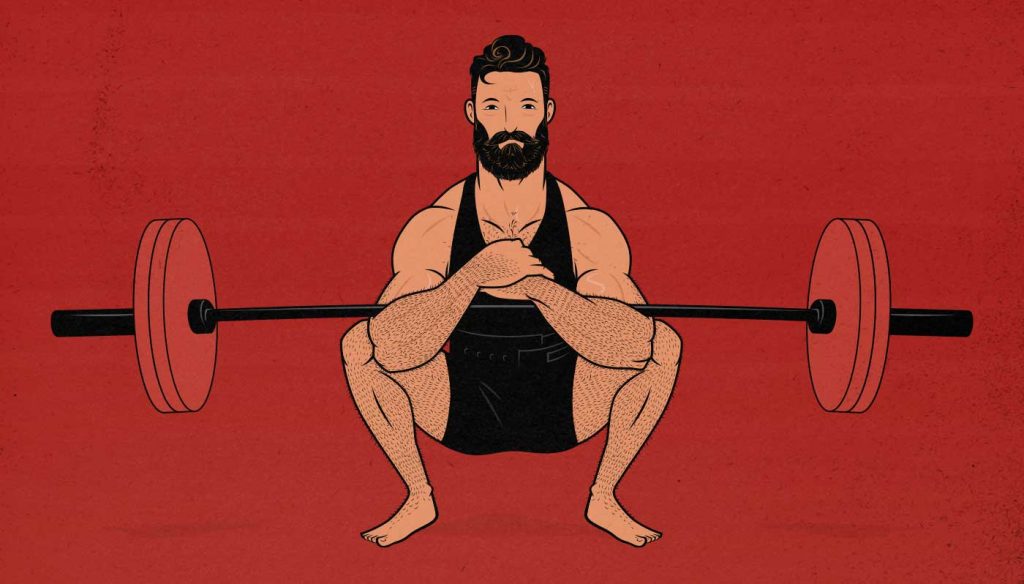
The Hypertrophy Rep Range: How Many Reps to Build Muscle?
How many reps should you do to gain muscle mass? In strength training, doing five reps per set is a popular way to gain mass. In bodybuilding, though, where the goal is to build bigger muscles as fast as possible, most people do sets of 8–12 reps. Which rep range stimulates more muscle growth?
Should we use different rep ranges for different lifts? If doing 5-rep sets on the bench press hurts our shoulders, should we use a higher rep range? If doing 12-rep sets of squats challenges our fitness more than our strength, should we use a lower rep range? And what about compound versus isolation lifts? Should we use lower reps for our compound lifts and higher reps for our isolation lifts?
Finally, what if we want to use a rep range that helps us gain both muscle size and strength? Does that mean we should use a mix of lower and moderate reps? For instance, lifting from 3 reps all the way up to 20 reps per set? Or is it better to use a rep range that’s halfway between strength training and hypertrophy training? For instance, doing 4–6 reps per set?
So, is there a hypertrophy rep range? And if so, what is it?
- A Moderate Rep Range is Often Best
- Are High Reps Good for Gaining Muscle Mass?
- Are Low Reps Good for Gaining Muscle Mass?
- Which Rep Range is Best for Gaining Strength?
- Are 5×5 Routines Good for Gaining Muscle Mass?
- Is There A Hypertrophy Rep Range?
- Different Rep Ranges for Different Lifts
- So, How Many Reps to Build Muscle?
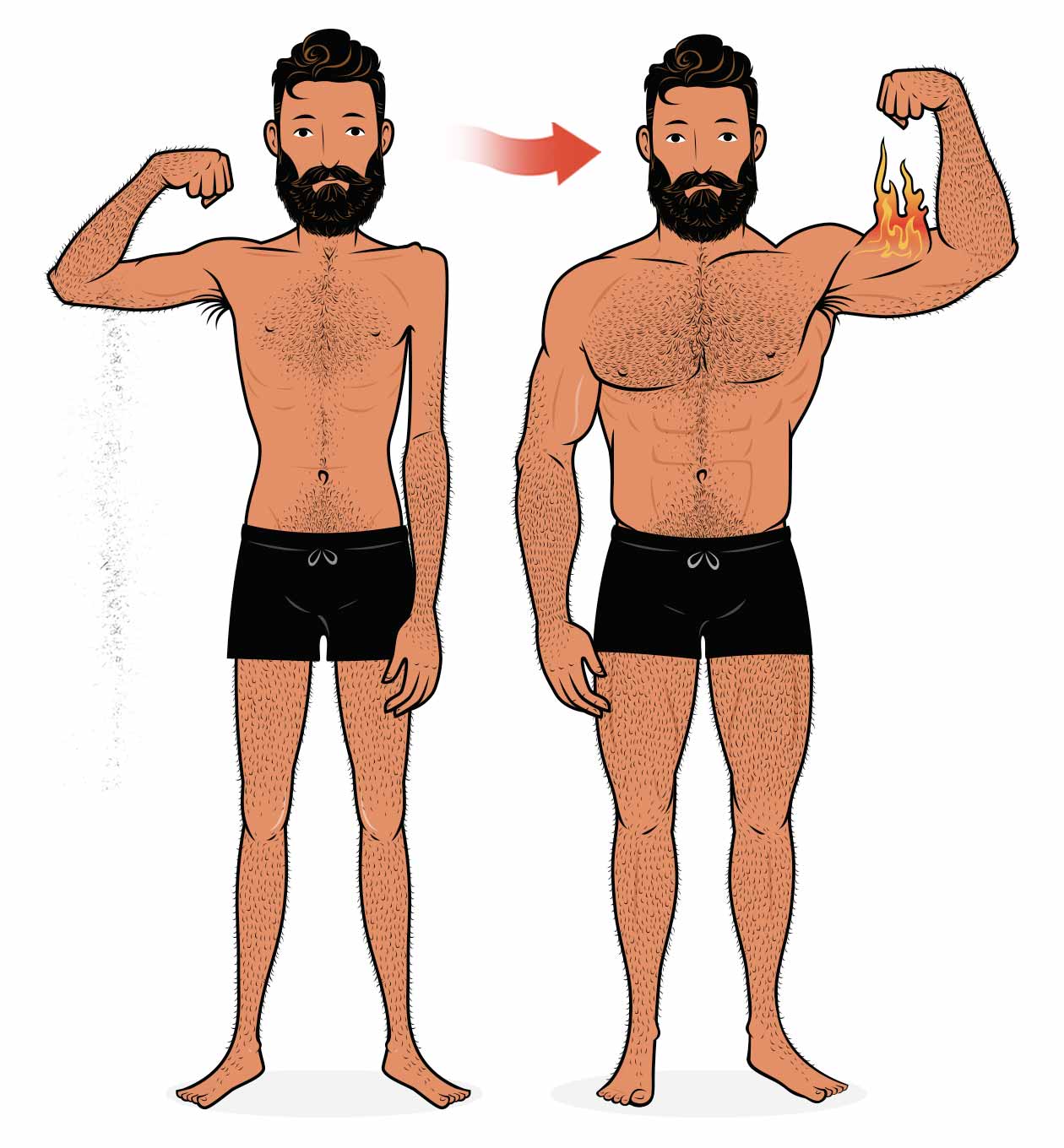
A Moderate Rep Range is Often Best
Sets of anywhere from 4–40 reps will stimulate muscle growth quite well, but most research shows that doing 6–20 reps per set is the most efficient way to build muscle. Bodybuilders often use the middle of that range, favouring 8–12 reps per set.
Of all the studies comparing rep ranges for muscle growth, the most famous is the study by Brad Schoenfeld, PhD. It found that the same amount of muscle growth from doing seven low-rep sets as from doing three moderate-rep sets.
- The strength training group did 7 sets of 3 repetitions. It took them 70 minutes to finish their workouts, and by the end of the study, they were complaining of sore joints and overall fatigue. Two of the participants dropped out of the study due to injuries.
- The hypertrophy training group did 3 sets of 10 repetitions. It took them 17 minutes to finish their workouts, they were eager to do more lifting, they finished the study feeling fresh, and they gained the same amount of muscle mass.
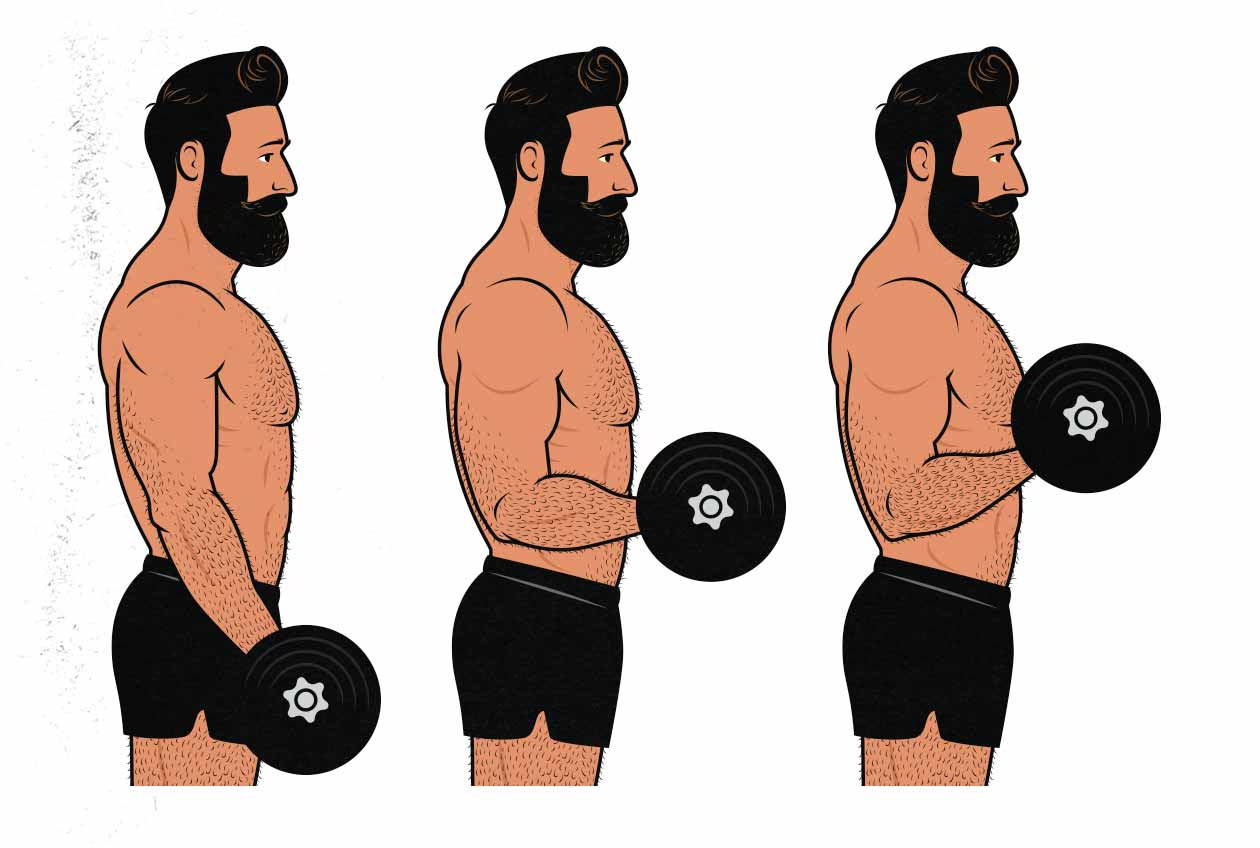
That caveat, of course, is that the group doing 7 sets of 3 reps gained quite a bit more 1-rep max strength, showing that low-rep training is indeed an important part of training for powerlifting. It’s just that for gaining muscle mass, using moderate rep ranges is much safer, more efficient, and easier to recover from, allowing us to stimulate more overall muscle growth.
The results of this study have been replicated several times (study, study, study). For instance, a recent study by Keitaro Kubo found that people doing 7 sets of 4 reps (7×4) on the bench press gained the same amount of muscle mass as those doing 3 sets of 12 reps (3×12). As we’d expect, the participants lifting in lower rep ranges saw greater improvements in their 1-rep max strength, but the moderate rep ranges proved to be a more efficient way to stimulate muscle growth.
One problem with these studies, though, is that they match training volume—total pounds lifted—instead of matching the number of challenging sets. If we look at a systematic review of 14 studies, we see that sets of 6–20 reps stimulate a similar amount of muscle growth per set, provided that we take those sets close enough to failure. That means that if we’re lifting within a moderate rep range, it’s better to count how many challenging sets we’re doing than to count how many pounds we’re lifting. These studies aren’t doing that. They aren’t matching the sets, comparing 3×4 versus 3×12 to see which stimulates more muscle growth, they’re matching the volume, comparing 7×4 versus 3×12.
These volume-matched studies clearly show that doing 3 sets of 12 reps stimulates as much muscle growth as doing 7 sets of 4 reps, but we don’t know how much muscle growth would be stimulated by doing 3 sets of 4 reps. After all, perhaps an equal amount of muscle growth was stimulated by the first 3 sets, at which point no more muscle growth was stimulated. That’s not completely crazy. We do see diminishing returns as training volume climbs higher. I’m skeptical of that, given that the training volumes weren’t that high, but even so, there’s only so much that we can conclude from volume-matched studies.
Are High Reps Good for Gaining Muscle Mass?
There’s quite a lot of evidence showing that high-rep sets can be good for building muscle. If we look at a study by Schoenfeld et al, we see that doing sets of 8–12 reps stimulates the same amount of muscle growth as doing sets 25–35 reps.
We have other examples of higher rep ranges stimulating plenty of muscle growth per set, too:
- A twelve-week study comparing 3×20 versus 3×10 found that both rep ranges produced the same amount of muscle growth.
- Another twelve-week study comparing 3×20-25 and 3×8-12R found that both rep ranges produced the same amount of muscle growth.
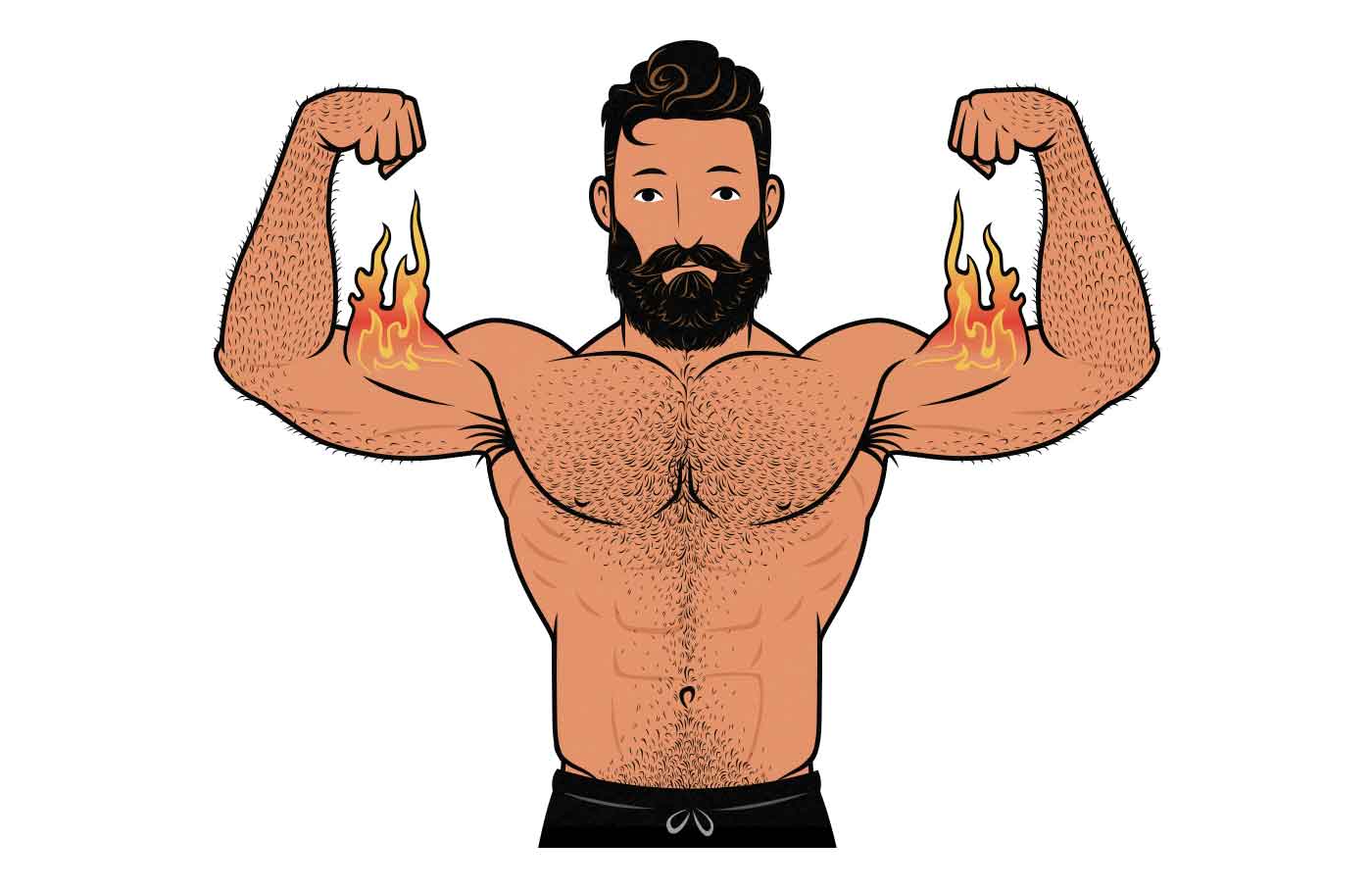
So the good news is that if you’re forced to use light weights or bodyweight training to build muscle, you can delve into those higher rep ranges. It will hurt, yes, but you can absolutely build muscle that way.
However, lifting in higher rep ranges is a fetid nightmare, especially when doing the bigger compound lifts. Dr Schoenfeld noted that the participants doing sets of 25–35 reps were in excruciating pain and would often throw up after finishing their sets. That’s why most people prefer doing low-to-moderate-rep sets.
Are Low Reps Good for Gaining Muscle Mass?
Low-rep sets will stimulate muscle growth, but not as efficiently as moderate or high-rep sets. For every low-rep set that you do, you may only stimulate 50–80% as much muscle growth as you would by doing moderate-rep sets. This makes strength training an effective but inefficient way to build muscle.
The most controversial question, by far, is where the lower cut-off is. Lifting in higher rep ranges is so painful that most people won’t do it. It’s not a popular style of training. Nobody is really advocating for it. But lifting in lower rep ranges is quite pleasant and easy. Squatting for five reps is much easier than squatting for ten reps. But are low reps good for building muscle?
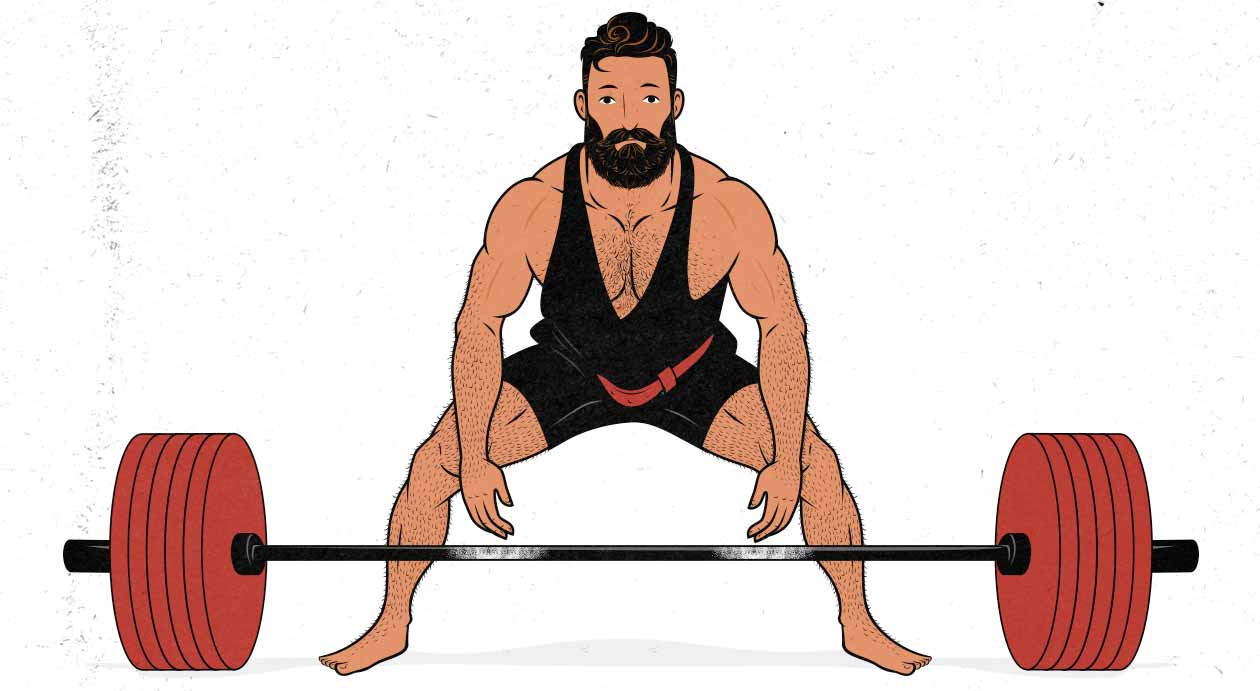
So, first of all, we do have some evidence showing that lower-rep sets don’t stimulate as much muscle growth:
- In this study, the participants lifting 2–6 reps needed to do 24 sets of the squat and bench press to build as much muscle as the participants doing 8–12 reps for just 13 sets.
- In this study, the participants lifting 2–4 reps for 3 sets gained less quad size than the participants lifting 8–12 reps for 3 sets.
- In this study, the participants lifting 13–15 and 23–25 reps gained a significant amount of muscle size in most muscle groups, whereas the participants lifting 3–5 reps did not.
These findings indicate that heavy load training is superior for maximal strength goals while moderate load training is more suited to hypertrophy-related goals when an equal number of sets are performed between conditions.
Brad Schoenfeld, PhD
It’s important to note the one study by Mangine et al that showed greater arm growth from doing sets of 3-5 reps than from doing sets of 10–12 reps. Mind you, they were training their entire bodies, and the difference in muscle growth was only seen in their arms. If we compare muscle growth throughout their entire bodies, the effect disappears. But even so, this remains an example of a study that at the very least found equal muscle growth between lower and moderate rep ranges. This study appears to be an outlier, but until we have more research, it’s hard to say for sure.
When reps are low, the number of hard sets is not a good proxy for hypertrophy. Rather, when reps are low, total volume should be calculated.
Mike Zourdos, PhD
It seems like when we’re doing fewer than six reps per set, we have to match the volume—total pounds lifted—when comparing those sets with moderate rep ranges. And when we do that math, we see that the muscle growth being stimulated per set drops quite a bit. For instance, doing 225 reps for ten reps is 2250 pounds lifted, whereas lifting 275 pounds for five reps is just 1375 pounds lifted. That’s why it seems to take nearly twice as many low-rep sets to stimulate as much muscle growth as a single moderate-rep set.
With that said, these differences in volume really only start to become significant when comparing rather different rep ranges. It’s possible that doing a set of five reps stimulates about as much muscle growth as doing a set of six reps. And even if it doesn’t, the difference is surely quite small. There’s no magic point as we move from six to five reps where all of a sudden people switch from gaining pure muscle size to gaining pure 1-rep max strength.
On the other hand, even small differences in rep ranges could result in different amounts of muscle growth over the longer term, and that could apply even within moderate rep ranges. It’s possible that doing sets of seven reps would eventually yield more muscle growth than doing sets of six reps. It’s possible that doing sets of eight reps could eventually stimulate more muscle growth than doing sets of seven reps. This is the point that Mike Zourdos, PhD, makes in Monthly Applications in Strength Sport:
While there isn’t necessarily sufficient evidence to say that the 15 reps would yield greater hypertrophy than the 6-rep example when sets are equated, without long-term data, it’s worth considering differential hypertrophy outcomes could occur over the very long term.
Mike Zourdos, PhD
There’s nothing wrong with lifting in lower rep ranges, but it might require doing more sets to stimulate an equivalent amount of muscle growth. And since low-rep sets tend to benefit from longer rest times and can be somewhat difficult to recover from, using lower reps comes with an opportunity cost. Plus, the main benefit of lifting in lower rep ranges is that it gives us practice lifting close to our 1-rep max. That’s incredibly important for powerlifters, but for people who are more interesting in becoming bigger, stronger, fitter, and better looking, that benefit disappears. For non-powerlifters, there’s no major advantage to lifting in those heavier rep ranges.
Which Rep Range is Best for Gaining Strength?
A bigger muscle is a stronger one, so any rep range that helps us build muscle will also help us gain strength. However, if you define strength by how much you can lift for a single repetition, then sets of 5–10 reps are best for building muscle in a way that will improve your 1-rep max.
Many people are simply interested in building bigger muscles. I can certainly relate to that. When I was skinny, I was far more desperate to get bigger than I was to get stronger. Even just comparing the popularity of bodybuilding versus strength training, we see that bodybuilding is several times more popular:

But even so, most of us also care at least a little bit about improving our general health, general fitness, and general strength. Lifting in moderate rep ranges is great for improving our general health and fitness. Lifting more total pounds per set, putting greater demands on our cardiovascular systems, and building more muscle mass are all great for our health and fitness. But what about our general strength?
Powerlifters measure their strength by how much they can lift for a single repetition—their 1-rep max strength. This is a special skill that we can practice by lifting closer to our 1-rep max. That’s why strength training and powerlifting training use lower rep ranges. But that doesn’t make us stronger, per se, it just helps us specialize our strength for powerlifting.
This can get confusing because bodybuilding and hypertrophy training have no official way of measuring strength. No official lifts, no rules about how to perform them, and no 1-rep max test. For that, people often turn to powerlifting, thinking that they need to test their 1-rep maxes to see how strong they are. And to improve their skill at lifting 1-rep maxes, they turn to strength training, as they should—that’s what it’s for.
However, this can lead people to assume that heavier rep ranges are better for developing strength, whereas moderate rep ranges are better for developing size. That’s not quite right. Muscle size is almost perfectly correlated with muscle strength, so the rep ranges that are best for helping us gain muscle size are also the rep ranges that are best for helping us become stronger. If our goal is to become generally stronger, we can usually do that more efficiently by lifting in the 6–20 rep range. As we get stronger within that rep range, we’re getting stronger in general, too.
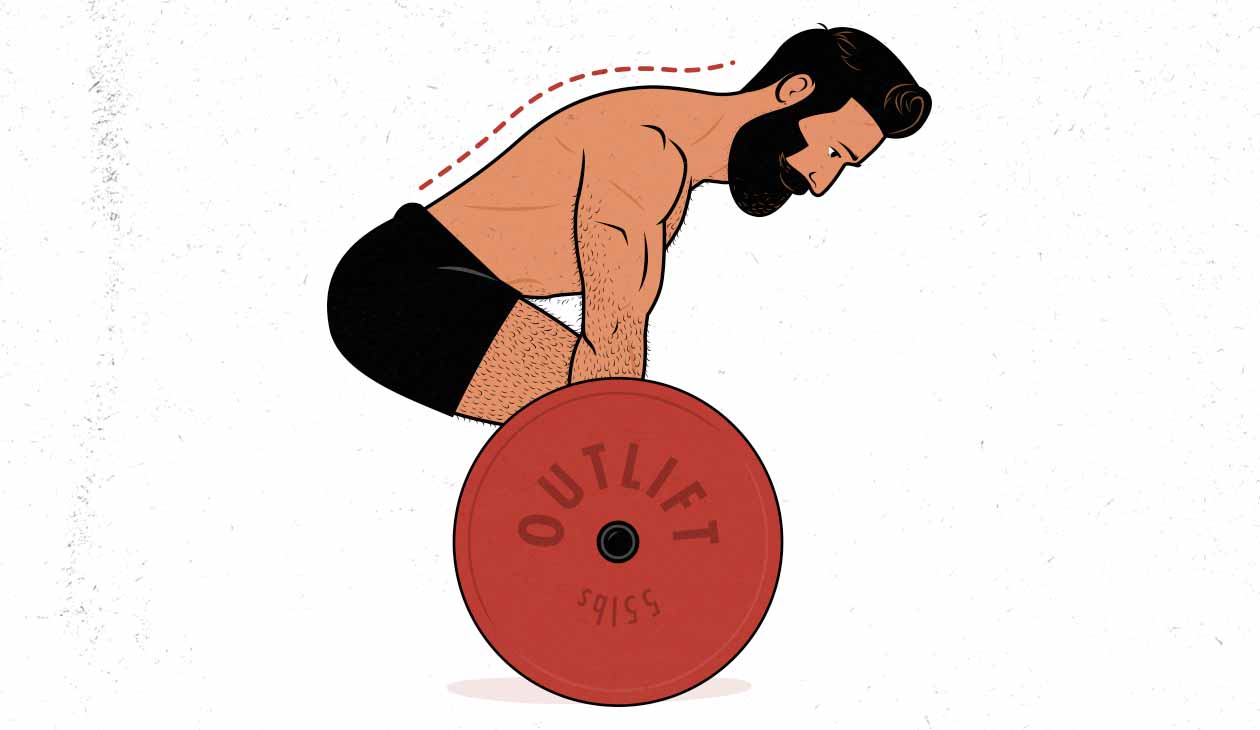
However, there’s another important aspect to general strength. A bigger muscle is a stronger muscle, yes, but we also need to make sure that we develop the relevant muscles. For instance, doing biceps curls will make our biceps bigger and stronger, but that won’t necessarily help us deadlift more weight. For that, we would need to build bigger hips, spinal erectors, and forearms. This is the problem that a lot of casual bodybuilders run into. It’s not that they’re “big but weak,” it’s that they aren’t big in the right places.
To become generally strong, then, we need to become better at lifts that develop our general strength. If we want to be able to pick up heavy things and carry them around, we might want to do conventional deadlifts and loaded carries. If we want to lift things overhead, we should be doing lifts like the overhead press. If we want to be able to carry stuff in front of our bodies, we might want to spend more time doing front squats. And if we want to be able to pull our bodies over things, we can do chin-ups.
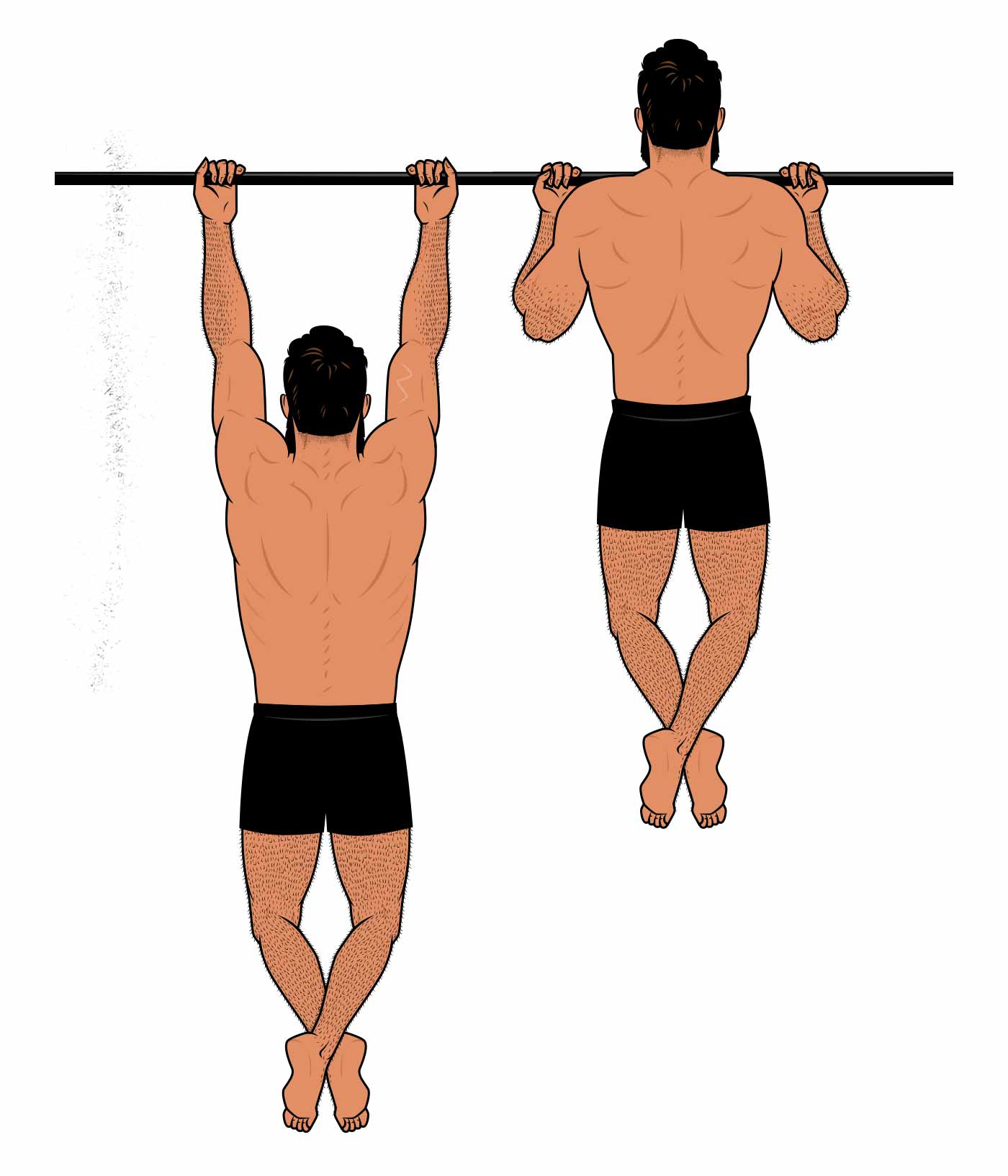
So building general strength has more to do with building bigger muscles by doing the big compound lifts, less to do with lifting in lower rep ranges. The exception to that rule is powerlifting, where our strength is measured by how much we can lift for a single repetition. For everyone else, though, we can measure our strength by how much we can lift in a variety of different rep ranges. For instance, someone who can bench 300 for a single is similarly strong to someone who can bench 275 for 5 reps or 225 for 10 reps.
Perhaps more importantly, going from benching 185 pounds for 10 reps to benching 225 pounds for 10 reps shows a significant improvement in strength. That means there’s no need to train for or test our 1-rep max to gauge our strength.
Are 5×5 Routines Good for Gaining Muscle Mass?
5×5 routines are good for building muscle, but doing slightly more reps is even better. For instance, you could stimulate a similar amount of muscle growth by doing 3 sets of 10 repetitions as you would by doing 5 sets of 5, keeping your workouts shorter or freeing up more time for other lifts.
5×5 routines are commonly used during the mass phases of strength training programs because they allow us to lift fairly heavy (over 80% of 1-rep max) while still getting in enough overall volume to build muscle mass. And they’re popular because they work. You can indeed build muscle with 5×5 workouts.
Now, most research shows that we build more muscle per set when doing at least 6–8 reps per set, and that may be true. But sets of five reps are right on the cusp of being ideal for gaining muscle. When we’re talking about small differences in rep ranges, the difference in muscle growth will likely be similarly small.
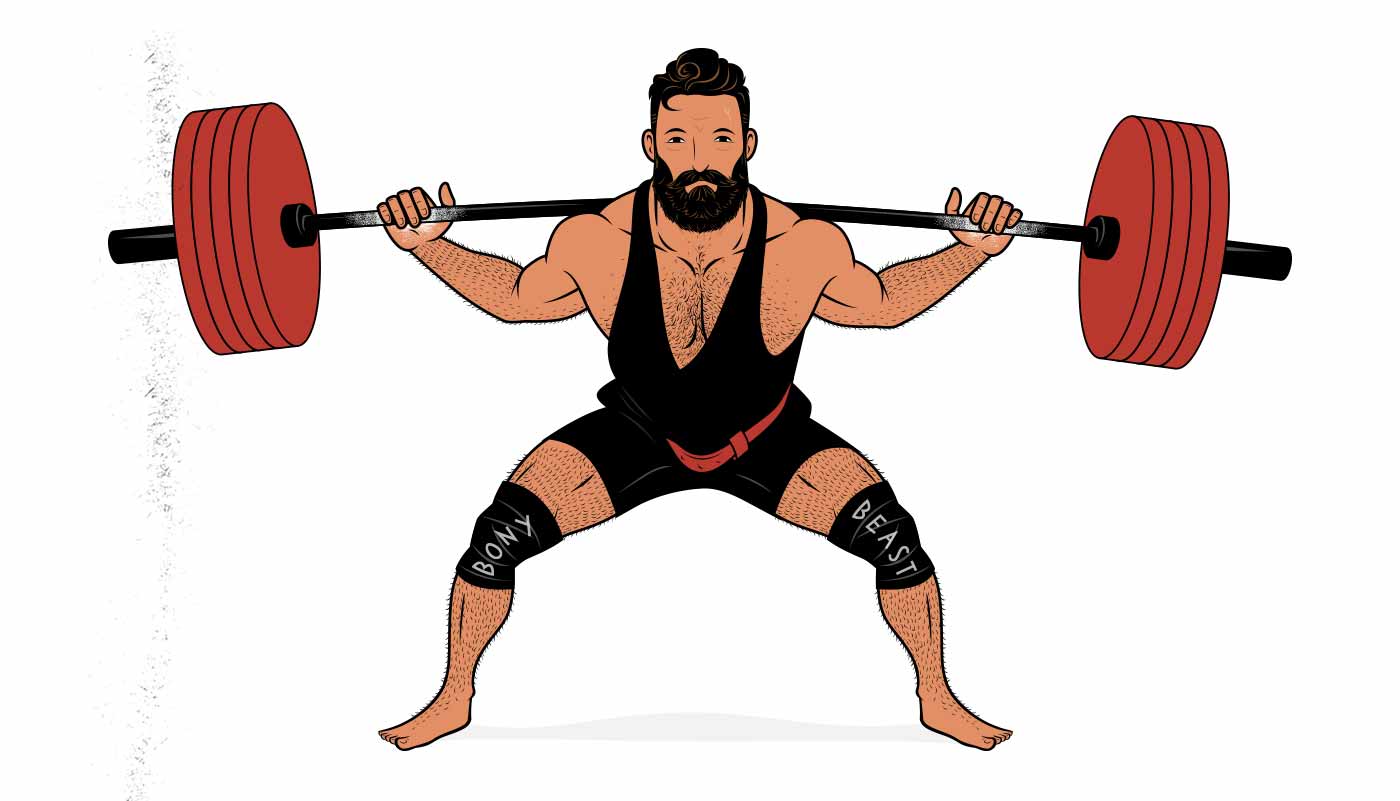
In the latest issue of Monthly Applications in Strength Sport, Greg Nuckols said that he suspects that sets of 3–5 reps aren’t as good at stimulating muscle growth as moderate-rep sets, but that they’re not that far off, either. We don’t necessarily need to do twice as many sets, but we might need to do a couple of extra sets.
My personal hunch is that low-rep sets (of around 3-5 reps) are a bit less efficient for muscle growth on a per-set basis, but not quite to the point of needing to equate for volume load.
Greg Nuckols, MA
For instance, instead of doing 3 sets of 12 reps (3×12), we might want to do 5 sets of 5 reps (5×5). This is the approach we see in 5×5 programs, such as StrongLifts 5×5, and it’s why people will often argue that it stimulates more muscle growth than lower-volume programs like Starting Strength, which uses 3 sets of 5 reps (3×5).
Now, does that mean that 5×5 workout programs are good for gaining muscle size? Not necessarily. Doing 5×5 on the bench press might stimulate the same amount of muscle growth as doing 3×12 on the bench press, yes, but we also need to consider that these lower-rep sets require longer rest times, that they can be harder on our joints, and that we need to do more total sets to get an equivalent benefit. As a result, someone might spend half an hour doing their 5×5 on the squat, finish it already feeling a bit tired, and then have to grind through a 5×5 on the bench press and then row. The full workout takes 60-75 minutes, they’ve only done three lifts, and they feel like they’ve worked pretty hard.
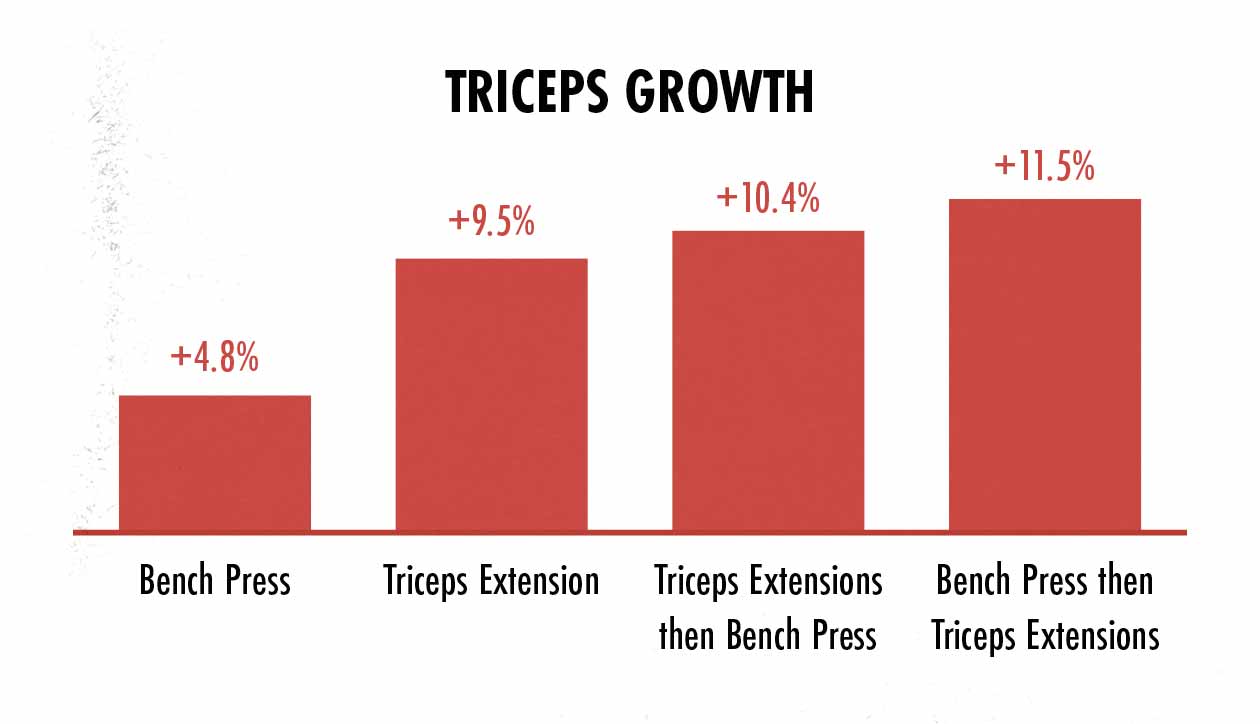
The problem is, we’re spending so much energy on so few lifts that it becomes hard to work all of our muscles. For instance, let’s consider the bench press. The bench press is great for stimulating growth in our chests and shoulders, but it’s not ideal for stimulating growth in our triceps (study). If we want to maximize the growth of our triceps, we also need triceps extensions. It’s certainly possible to do 5×5 on the bench press and then move on to triceps extensions afterwards, and then lateral raises, and so on. But you can imagine how those workouts could get quite long.
Plus, this is assuming that muscle growth is maximized with just three sets per muscle group per workout. If we look at the ideal training volume for gaining muscle size, that doesn’t seem to be the case. It seems that muscle growth is maximized by doing 4–8 sets per muscle group per workout. That means that to maximize muscle growth, we wouldn’t be doing five sets of five, we’d be doing 6–10 sets of five. When volumes start climbing higher like that, it can pay to have an easier and more efficient way to stimulate muscle growth.
If we compare to how a bodybuilder trains, we can see the advantage of using moderate rep ranges. An intermediate bodybuilder might spend ten minutes doing 3×12 on the bench press and then another ten minutes doing 3×15 skull crushers. Within that same 20-minute timeframe, they’ve stimulated the same amount of chest growth, they’ve doubled their triceps growth, and they’re probably still feeling fairly fresh. It’s an easier and more efficient way of building muscle.
So it’s not that we can’t build muscle with 5×5 strength training programs, it’s just that hypertrophy training (aka bodybuilding) programs help us gain muscle size faster and more efficiently.
Is There A Hypertrophy Rep Range?
Sets of 1–5 stimulate less muscle growth than sets of 6+ reps, making them less efficient. And sets of 20+ reps are more painful, making it difficult to push ourselves hard enough to stimulate growth. That’s why 6–20 reps is often dubbed the “hypertrophy rep range.”
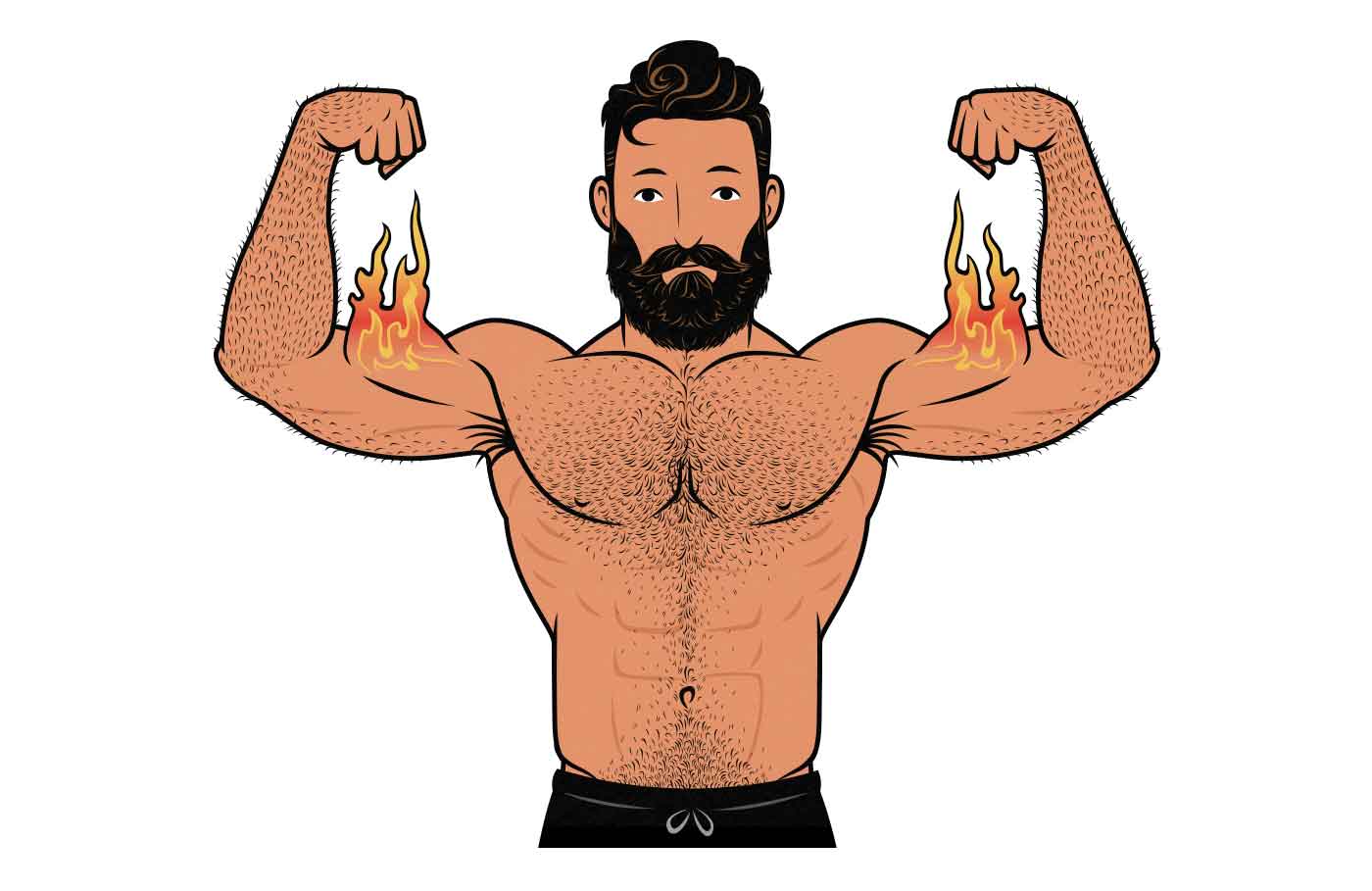
According to experts like Greg Nuckols, MA, sets of 4–40 reps are ideal for gaining muscle mass. According to others, such as Mike Israetel, PhD, sets of 5–30 reps are best for building muscle. We also have researchers like James Krieger, MS, favouring sets of 8+ reps. Still, all these hypertrophy rep ranges are essentially the same, and they become even more similar once we start putting them into the context of a good bodybuilding/hypertrophy program.
The hypertrophic stimulus and fatigue generated by each set between roughly 5 and 30 reps are about the same. Volume and intensity cause growth and fatigue, and when one goes up per set, the other goes down to preserve a roughly even effect.
Mike Israetel, PhD
When we’re doing sets of 1–5, the sets tend to be harder on our joints and connective tissues, they can have higher rates of injury, and they can take longer to recover from. There are problems with doing sets of 20–40 reps, too. First, we need to take them closer to muscular failure to reliably provoke muscle growth. Second, taking high-rep sets to failure is so painful that it can make people vomit, give up, or hate training. And third, higher-rep sets can cause a tremendous amount of muscle damage, making our workouts harder to recover from.
Since training with more moderate loads may be more time efficient and carry a lower injury risk, you’re best off spending most of your training time in the more moderate load range, with low reps mixed in for strength benefits, variety, and personal preference.
James Krieger, MS
Finally, we have a new systematic review from Dr Brad Schoenfeld concluding that any load over 30% of our 1-rep max can be heavy enough to stimulate muscle growth, provided that we bring our sets close enough to failure. However, he notes that low-rep sets stimulate less muscle growth per set while inflicting greater stress on our joints, whereas higher-rep sets take longer and are quite a bit more painful. As a result, he recommends defaulting to moderate rep ranges when training for muscle growth.
So although sets of 4–40 can be good for stimulating muscle growth, it’s often easier to build muscle if we spend more of our time lifting in the 6–20 rep range. And even within that shrinking rep range, different lifts respond better to different rep ranges, narrowing it further still.
Different Rep Ranges for Different Lifts
When we’re picking our rep range, our goal is to challenge our muscles with enough overall volume, to make sure that we aren’t being limited by our cardiovascular fitness, and to avoid injury and pain. As a general rule of thumb, that’s why moderate rep ranges are so convenient. But, as you can imagine, different lifts challenge us in different ways.
When we’re squatting and deadlifting, we’re engaging tons of muscle mass, lifting heavy loads, sharing the load between several joints, and moving the weight through a large range of motion. It’s easy to be limited by our cardiovascular systems. As a result, it’s often better to use lower reps: 4–10 reps per set.
When we’re bulking up our necks, though, our neck flexors and extensors are rather small. We can do higher reps without being limited by our fitness, it doesn’t tend to hurt that much, and it might be safer. So with neck training, we might want to use higher reps: 15–40 reps per set.
So instead of doing 6–20 reps for every lift, we want to use different parts of the rep range at different times. Lower reps tend to be ideal for the bigger compound lifts, giving us loose rep range recommendations for our five big hypertrophy lifts of, say:
- Deadlifts: 4–10 reps per set.
- Front Squats: 5–12 reps per set.
- Bench Press: 6–12 reps per set.
- Overhead Press: 6–12 reps per set.
- Chin-Ups: 5–12 reps per set.
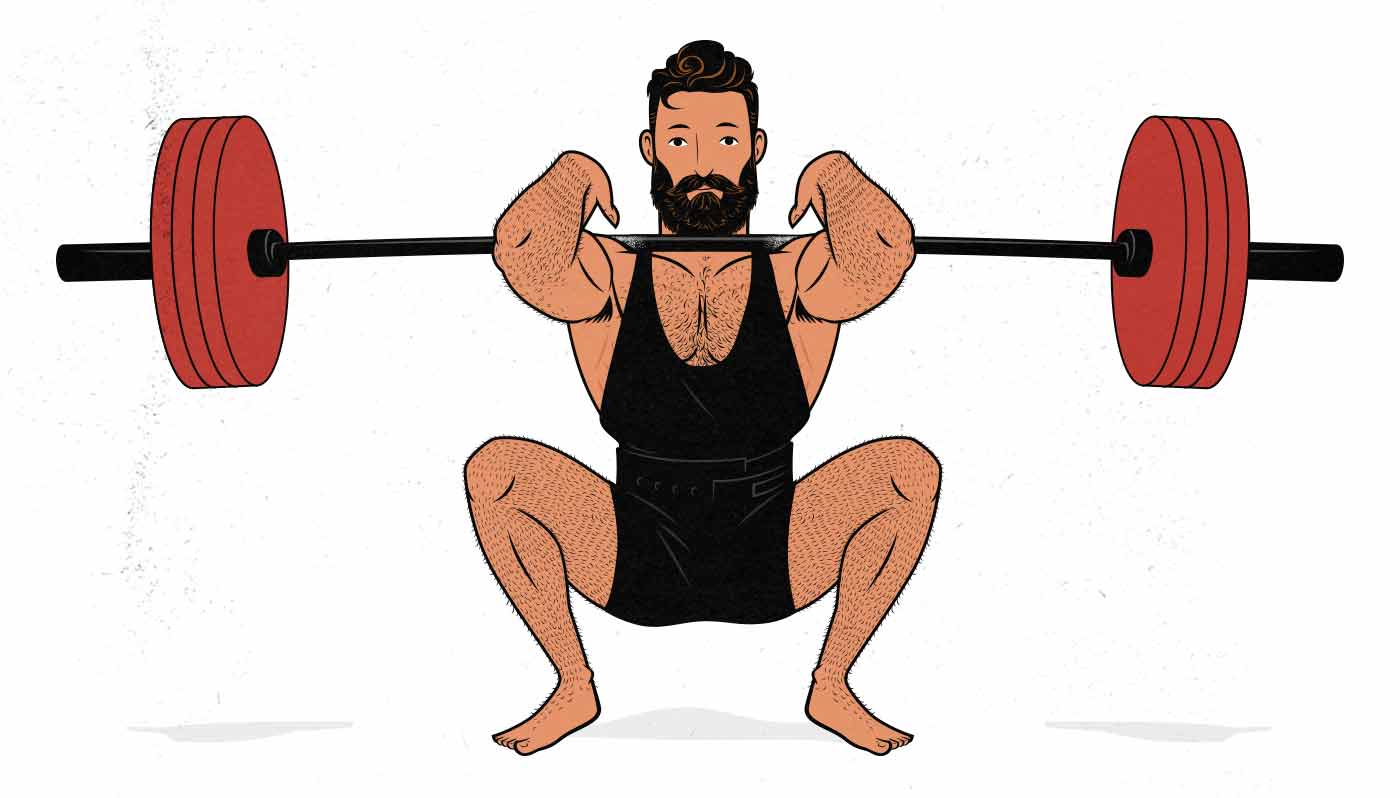
And then the ideal rep range climbs higher for assistance and accessory lifts, which are lighter, less fatiguing, and can sometimes tolerate a bit of technique breakdown. Here are some loose recommendations for some common isolation lifts:
- Biceps Curls: 8–15 reps per set.
- Rows: 8–15 reps per set.
- Dips: 8–15 reps per set.
- Dumbbell Bench Press: 8–15 reps per set.
- Skullcrushers: 8–15 reps per set.
- Romanian Deadlifts: 8–15 reps per set.
- Zercher Squats: 8–15 reps per set.
- Lateral Raises: 10–20 reps per set.
- Overhead extensions: 10–20 reps per set.
- Push-Ups: 10–30 reps per set.
- Wrist curls: 12–30 reps per set.
- Neck curls: 15–30 reps per set.
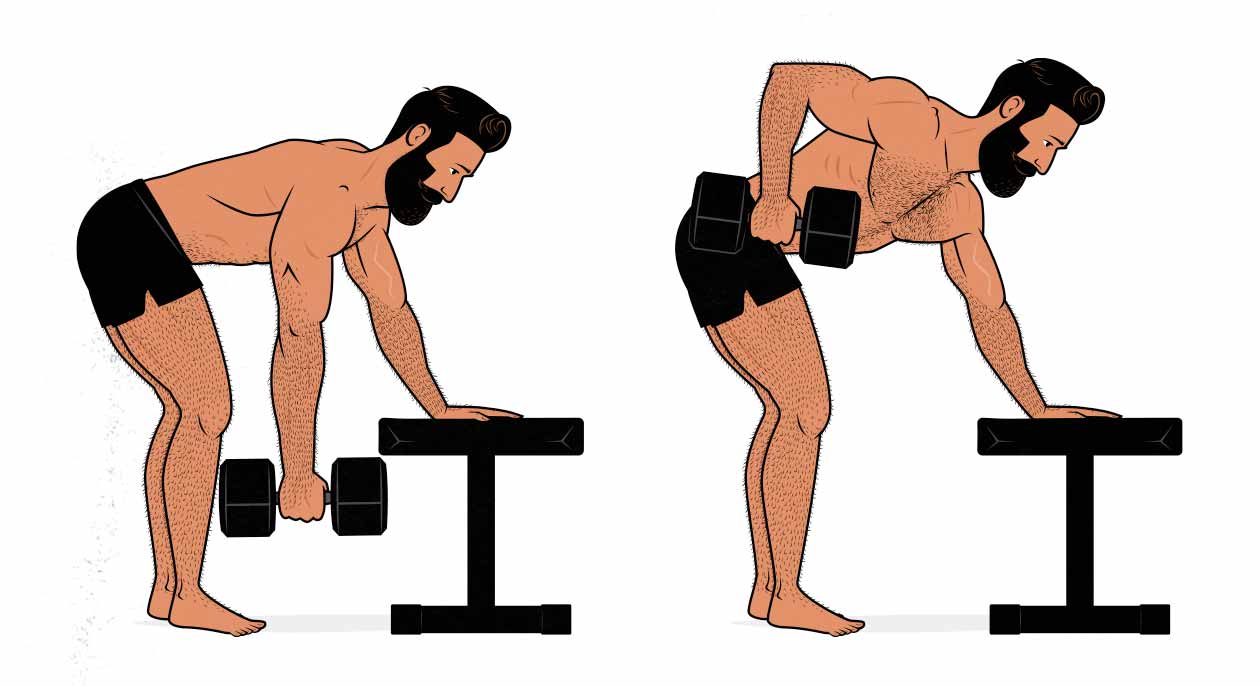
Genetics and personal preference will factor into what rep ranges you prefer, too. Some people’s shoulders ache when they bench too heavy, others when they bench too light. Some people’s lower backs get beat up with low-rep sets of deadlifts, whereas others get winded before they can finish a set of ten. There’s plenty of room for personal preference.
So, How Many Reps to Build Muscle?
Doing around 6–20 reps per set is usually best for building muscle, with some experts going as wide as 5–30 or even 4–40 reps per set. For bigger lifts, 6–10 reps often works best. For smaller lifts, 12–20 reps often works better.
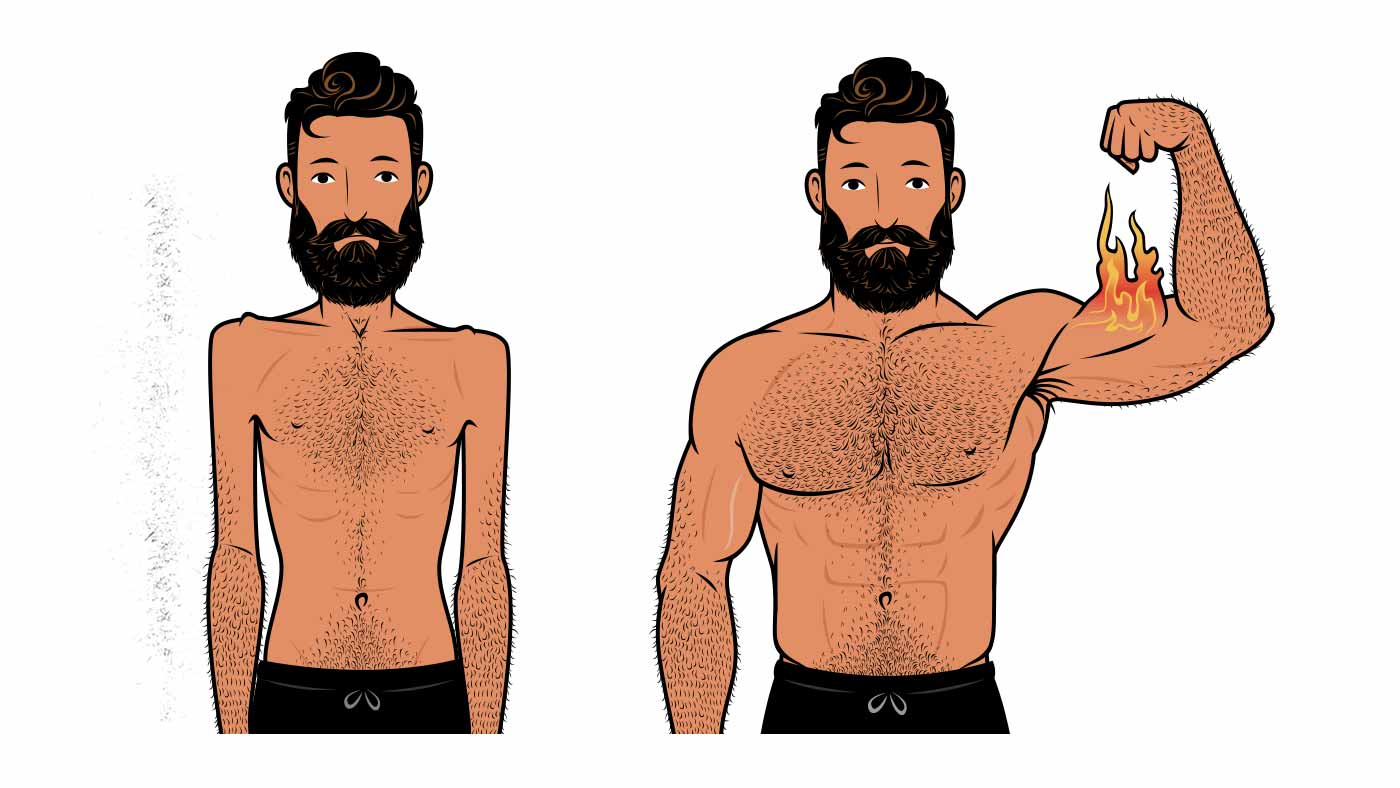
If you have sore joints, it can help to use higher rep ranges, doing 12–40 reps per set. And if you’re interested in improving your 1-rep max, you might want to favour lower rep ranges, doing 4–10 reps per set. Otherwise, it’s best to spend most of your time doing 6–20 reps per set, occasionally going as low as 4 reps and as high as 40 reps per set.

If you want a customizable workout program (and full guide) that builds these principles in, check out our Outlift Intermediate Bulking Program. Or, if you’re still skinny, try our Bony to Beastly (men’s) program or Bony to Bombshell (women’s) program. If you liked this article, I think you’d love our full programs.



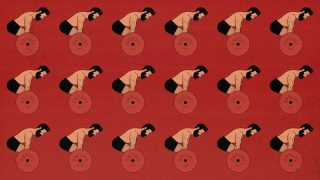



Awesome!!!! Didn’t even know Outlift was a thing. Great article
Thanks, Sam! 😀
It’s still a super new site. We’ve been trying to put up a bunch of good content before officially announcing it the Bony to Beastly and Bombshell communities. That way it’s more than just a sparse site. But I think we’re getting to the point where we’ve got a lot of content up.
Our other two sites are more specifically about helping naturally skinny people bulk up, so with this site we want to go beyond that. More intermediate content, and more general health, fitness, and strength content. Still mostly focused on building muscle, though. We’ve still got our hardgainer roots!
In the section, “Are Low Reps Good For Building Muscle?”, the math doesn’t seem to be right. You say,
“In this study, the participants lifting 2–6 reps needed to do 24 sets of the squat and bench press to build as much muscle as the participants doing 8–12 reps for just 13 sets.”
This shows the low rep range to require less volume for more muscle growth. If we take the low end of the low rep range (2×24) we get 48 reps, against (8×13) 104 reps for the high rep range. That’s less than half the volume required for the same gain. Even if we take the high end (6×24) we get 144 reps, whereas with the high rep range (12×13) we get 156 reps.
This shows that the lower reps stimulated more muscle growth, when considering volume.
Of course, I’m sure most people would prefer to go with the moderate rep range for fewer sets, for reasons you mention some of later in the article, but this calculation just wasn’t accurate by total volume of reps.
Hey Eric,
Volume isn’t calculated via reps (at least not as far as I’m aware and not in the hypertrophy research I’ve seen). It’s either calculated as total poundage lifted (as you’ll see in Schoenfeld studies) or as number of challenging sets (as you’ll see guys like Greg Nuckols using).
If we’re talking about muscle growth per rep, then yes, better to use lower rep ranges so that each rep is damn heavy. But if we’re talking about muscle growth per set, better to use moderate rep ranges so that we’re lifting more total poundage each set.
Practically speaking, you’re right. It’s easier to do the moderate rep range. Doing 24 sets of 3 reps, maybe 2–5 minutes of rest between sets, a few warm-up sets beforehand, we’re talking about a good 2–3 hours of work. But if we’re doing 13 sets of 10 reps, maybe 2–4 minutes of rest between sets, fewer warm-up sets needed, we’re talking maybe an hour of work. The workouts become much, much more efficient. Plus, they’re also much easier to recover from.
When doing 4 sets of 8 reps can you go up in weight on each set for muscle growth
When you increase the weight from set to set while keeping the reps the same, those are usually called “ramping sets.” That can stimulate muscle growth, yeah, but it’s probably not ideal. The first sets that we’re doing, where we’re using lighter weights, often aren’t brought close enough to failure to stimulate a maximal amount of muscle growth. If we challenge ourselves with the first set, our strength will typically go down a bit on the next set.
What often works better, then, is keeping the weight the same and pushing a bit closer to failure with each set. The idea being to start with just a few reps in reserve and finish our final set without actually hitting failure.
For example:
Set 1: 8 reps with 225 pounds, 3 reps in reserve
Set 2: 8 reps with 225 pounds, 2–3 reps in reserve
Set 3: 8 reps with 225 pounds, 1–2 reps in reserve
Set 4: 8 reps with 225 pounds, 0–1 reps in reserve
If you increase the weight from set to set and it causes you to get fewer reps with each set, that’s called pyramid training, which looks more like this:
Set 1: 10 reps with 225 pounds
Set 2: 8 reps with 235 pounds
Set 3: 6 reps with 245 pounds
Set 4: 4 reps with 255 pounds
Pyramid training can work, but it often makes more sense to reverse it, starting heavier and then stripping weight off the bar. That allows us to lift heavier weights while our muscles are still fresh and strong, and then burn ourselves on higher reps afterwards, often allowing for more total weight lifted. That’s called Reverse Pyramid Training, like so:
Set 1: 4 reps with 265 pounds
Set 2: 6 reps with 255 pounds
Set 3: 8 reps with 235 pounds
Set 4: 10 reps with 215 pounds
So can we add weight from set to set for muscle growth? Yes, but it’s usually better to either keep the weight the same from set to set or to strip weight off the bar from set to set.
Admittedly, though, the data is lacking on this. There’s not a lot of research looking into ramping sets (or top sets). And even the research on Pyramid Training is pretty sparse.
I hope that helps!
Can someone please explain what it means to say 6-20 rep range? What does that actually mean? if you say 4 sets of 10-12 reps, how does that actually look?
Hey Jesse, that’s a really good question and, yeah, I totally should have explained that.
Saying that the hypertrophy rep range is somewhere in the neighbourhood of 6–20 reps means that sets ranging from 6 reps to 20 reps can all be ideal for stimulating muscle growth. What that means is, if you’re making a hypertrophy training program, a workout might look like this:
Deadlifts: 4 sets of 6 reps
Bench Press: 4 sets of 10 reps
Biceps curls: 3 sets of 12 reps
Skullcrushers: 3 sets of 15 reps
Lateral raises: 2 sets of 20 reps.
This workout uses 2–4 sets of 6–20 reps, doing fewer reps on the bigger compound lifts, more reps on the smaller isolation lifts. And when the reps are lower, we tend to do slightly more sets. We might use that workout for a few weeks or months, adjusting as needed depending on how we’re progressing, and then switch things up a bit to keep things fresh.
If we say 4 sets of 10–12 reps, that could mean:
4 sets of 10 reps
4 sets of 11 reps
4 sets of 12 reps
Or it could mean doing 4 sets of 10–12 reps, starting with a weight you can do 10 reps with, trying to get more reps every workout, and adding weight every time you’re able to do 12 reps. That’s the approach commonly used in Reverse Pyramid Training programs.
Speaking of reverse pyramid training, another way to do sets in the 6–20 rep range would be to strip some weight off the bar each set, perhaps starting with 200 pounds for 8 repetitions, then 180 pounds for 10 repetitions, and then 160 pounds for 12 repetitions.
This is all to say that doing sets anywhere between 6–20 reps tends to result in a maximal amount of muscle growth, but depending on the exercise, the person, and their goals, sometimes there’s a reason to use 6-rep sets instead of 20-rep sets or vice versa.
I hope that helps.
Hi. So far, when I do weighted chinups for 3 sets, I get 8 reps on the 1st set, 5 reps on the 2nd set, and 4 reps on the 3rd set. This comes from resting 3 minutes between sets. All sets are to failure with good form (chest to bar). Does this mean only that only the 1st set stimulated sufficient hypertrophy because it was in the 6-20 rep range? While the other 2 sets stimulated mostly stimulated strength?
If so, am I better off reducing the weight on the 2nd and 3rd set only to make sure I never go below 6 reps?
Hey Rob, that’s a good question.
There are a couple downsides to lower rep ranges for hypertrophy. The first that doing fewer reps per sets means we’re lifting less total weight each set (less volume), which seems to stimulate less muscle growth. That can be solved by doing extra sets, though, which is where the second problems comes in: lower-rep sets are more fatiguing and can be harder on our joints.
So in your situation, that gives us:
1. As you lose reps with every set, you’re lifting fewer pounds, and thus stimulating less muscle growth.
2. You aren’t lifting heavier weights, though, so there’s no extra fatigue or strain on your joints.
You’ve got a couple options. The first option is to rest longer so that you aren’t bleeding as many reps between sets. You could try 5-minute rest periods. That can start making your workouts take longer, though, so I’d understand if you didn’t want to do it.
Another approach is to lower the weight so that you’re using your 10RM on the first set. That way when you do 8 reps, you have 2 reps left in reserve. Next set, maybe you get 8 reps with 1 in reserve. And then on your third set, you can do 8 reps with 0 in reserve. That tends to work quite well, and even if the numbers aren’t quite that perfect, you’ll probably be doing more than 5 reps on the third set. This is how we normally recommend that people train, leaving some reps in reserve, especially on earlier sets, and especially when so many reps are bleeding out from set to set.
But don’t worry too, too much about always staying above 5 reps. 4-rep sets might not be quite ideal, but you’ve already done an 8-rep set, which is. That’s fine. The goal is just to keep most of our training in the hypertrophy rep range. Maybe just stick with that weight until you’re getting 8 reps on all three sets.
Awesome information about reps. How about sets what has the best results. For example, 4-5 sets of 10-12 reps or is 6-10 sets of 10-12 reps have better results.
Hey Elias, thank you!
We’ve got a whole article on how many sets to do. Check this out: https://outlift.com/hypertrophy-training-volume/
Here’s the summary at the end: “There’s no single ideal amount of volume for maximizing hypertrophy, but a good rule of thumb is to aim for 6–15 reps per set, 3–8 sets per muscle per workout, and to train our muscles 2–3 times per week. That yields a training volume of 9–18 sets per muscle group per week, which is right about perfect for building muscle. You can do that with 2–3 full-body workouts per week or with body-part splits.”
Thank you Shane for your response! I’ve been doing the 8-10 reps and 6 sets for three weeks now. Going to continue for another three weeks. Started working out since January 2020. Also, reading and researching on your articles, so going to follow other routines after that.
Thanks for all the info
My pleasure, Elias. Good luck! 🙂
Great article
Thank you, SnkyB 🙂
Funny that this is published. Since Saturday been training 20 reps with my mate who is 57. I’m training him, he wants to do lighter weights and more reps mainly for his joints.
To be fair, my shoulders are killing me since Tues.. Probably done over 120 reps in total. Including burn out sets. Done shoulder press 30kg for 3 x 20 reps. Usually would do 60kg for 3 x 4. So it was good for a change.
Were see. Good to train slightly differently. Hopefully I can get some new gains from training this way. Good to mix it up and to be fair, my form seems better.
Totally! Different methods work best for different people. Good to have such a wide rep range we can use to build muscle. And I think you’ll get some new gains, yeah 🙂
Sorry if I come off not understanding, but you mention A LOT on things I wasn’t searching for. I searched for what is the ideal rep and set to stick with to build from and you mention a plethora of different studies and my head now is so confused. So what is the general idea or rule of thumb to go off of? I understand it has to be tweaked but for someone who is just trying to build muscle and size, what do you recommend? Sorry, all that info above isn’t pertaining to me.
Hey Dustin,
A good place to start is 3 sets of 8 reps.
If you don’t want to dive all that deep into workout programming, you might want to follow a workout program instead of building your own. That way all the work is done for you, and you can learn what a good workout program looks and feels like. Otherwise, yeah, it can get a bit tricky. Fun, though, I think 🙂
Not 100% correct. Your limit strength is your base. Increasing your 1RM will help with lifting more weight in the higher rep ranges. If you only focused on 3×12 for example it would be hard to significantly increase your strength on that 3×12 lift.
Squat 2×8, 2×6, 4×4. Next session, 2×10, 2×10, 3×10. The different intensities help you gain more strength and size in the long run. Doing reps from 1 to 20 for example.
So powerlifting training is very beneficial for hypertrophy if incorporating higher reps also, as it will make you able to do 20 reps with much higher weights. I know some people who squat 200kg x 20 reps. Comparing that do 20 reps with 80kg, big difference.
Hey Alfons, if I understand you correctly, you’re saying that heavier strength training can improve our strength in moderate rep ranges, allowing us to use more weight when doing our hypertrophy training, and thus stimulate more muscle growth, right? That’s an interesting idea and one that’s been debated quite a lot.
To get the most out of the muscle mass we already have, training in a given rep range is likely the best way to improve our strength in that rep range. So if we want to get stronger at doing 3-rep sets, then 3-rep sets are a great way to gain that strength. But if we want to get stronger at 12-rep sets, then 12-rep sets are a better way to do that. The reason this is confusing is because when most people talk about “strength,” they’re talking about maximal strength—how much someone can lift for a single repetition. And it’s true that lower rep ranges do a better job of improving our 1-rep max. But if the goal is to improve your strength in moderate rep ranges, then training in moderate rep ranges is perfect for that.
Thing is, we can also increase our strength by gaining more muscle mass, and doing at least 5–6 reps per set is better for that. So not only would doing 12-rep sets make us stronger at doing 12-rep sets with the muscle we already have, but we’d also be building more muscle mass.
Now, that doesn’t invalidate the idea of combining strength training and hypertrophy training. Perhaps using a variety of rep ranges is indeed better for building muscle. Or maybe gaining strength in lower rep ranges has useful carryover to our strength in higher rep ranges. If we look at the research, there’s a recent study showing that, yes, doing strength training before hypertrophy training can slightly improve muscle growth. But we also have research showing that sticking with 8–12 reps seems to work just as well as varying your rep ranges. And we have research on periodization that doesn’t show a large effect from alternating between strength and hypertrophy training phases.
With all of that said, I do think it’s useful to use a variety of rep ranges. If someone’s goal is to build muscle, doing most sets in the 6–20 rep range, but also incorporating some sets in the 4–6 and 20–40 rep ranges can work very well.
Hi I have found this fascinating, thank you! I’m training at home during lockdown so limited with equipment. I was interested to read about increasing reps and sets if you can’t go heavier to build muscle mass. My question is, if I can go heavier but have to drop reps (say from 10 to 8) for 3 sets is that better than increasing the number of sets at the same weight? Thanks!
Hey Jill, that’s a good question. The simplest answer is that 3 sets is a great number of sets per exercise per workout—no need to increase. And going from 10 reps to 8 reps is perfectly fine—both are in the middle of the hypertrophy rep range. So if everything is going well, I’d increase the weight instead of the number of sets.
Going a bit deeper, the more sets you do, the more muscle growth you’ll stimulate… up to a point. So if you go from doing 1 set to doing 2 sets, or go from 2 sets to doing 3 sets, you’ll almost certainly gain more muscle. If you increase from 3 sets to 4 sets, the difference may be minimal, but it may still help. And going from 4 to 5, there may be no difference at all. Then from 5 to 6, perhaps that’s more than you can recover from, and so that extra set actually does more harm than good.
The ideal number of sets depends on a few different factors, though, including your genetics, how strong you are, how often you train, which lifts you’re doing, how close to failure you’re going, how stressful your life is, and so on.
If you’re doing 3 sets, there’s a good chance that going up to 4 sets could stimulate more muscle growth, regardless of whether you’re doing 8 or 10 reps per set. To figure that out, I’d pay attention to how much of a pump you get in your muscles, how pooped you are after your workouts, how sore you are during the next couple of days, and whether you’re able to improve your performance during the next workout.
If the workouts are too easy (minimal pump, muscles not tired at the end of the workout, minimal soreness, not much progress) then I’d consider adding sets.
If all of that is going well (good pump, tired muscles at the end of the workout, some soreness, and steady increases in performance) then I’d stay with your current volume.
If you’re starting to feel beat up (crushed at the end of workouts, lingering/overlapping soreness and aches, strength plateaus) then maybe consider easing back on the sets, at least until you feel recovered and fresh again.
But whether adding sets or not, yeah, I’d go up in weight. Drop from 10 reps to 8 reps, then work back up to 10 reps 🙂
Shane, thank you so much for taking the time to reply to me! I really really appreciate it. I came across your site as I was looking specifically at how to gain muscle mass in a situation where the ability to increase weight each time is limited. There may come a point, for instance, when I have no more plates to add on for the deadlift, and I suppose what you are saying is don’t go up too much in number of sets as the point may come where I do more harm. But I could increase reps?
Yeah, exactly 🙂
There’s more than one way to un-skinny a cat, but a good rule of thumb is to think of your volume as the number of challenging sets you do. And in this case, we can define “challenging sets” as the ones that bring you within 0–3 reps of muscle failure. So if you’re adding more sets, but the sets aren’t challenging anymore, then that still gives you a volume of 0—not good.
A better approach is to add weight and/or add reps, ensuring that your sets stay challenging even as you grow stronger.
Nothing wrong with adding sets, but do that independently of adding weight/reps. Add weight or reps AND as sets as needed. Doing 3 sets per exercise is a great default, though, so I wouldn’t fiddle with it too much unless you really feel eager for more or you start running into progress plateaus.
Hey Shane, I briefly read through each part of this article and it explained a lot, so thank you! I have a small problem with my bench. I have been doing pyramid type training, like you mentioned in another comment, where I increase the weight with 3-4 warm up sets then 1 working set as close as possible to failure. Since I started doing this one set to failure with as much as weight as possible for around 6-12 reps with perfect form and full range of motion, the weight I am using on the barbell for my squats and bent over rows is going up and I am seeing results! As for my bench though not so much. My bench has been at about 135 pounds for reps for the longest time. I’ve tried to increase it over time. So what I used to do is 4 sets of 8-12 of just 135 pounds. So I thought that since I had done this for so long it was time to increase it by 5 pounds. Didn’t work so well. My form got sloppy and I wasn’t able to pump out as many reps. So i tried the 3-4 warm up sets and 1 working set to failure for my bench so it would like this
Set 1: 95 pounds 12 reps
Set 2: 115 pounds 10-12 reps
Set 3: 135 pounds 8-10 reps
Set 4: 145 pounds 6-8 reps
Set 5: 155 pounds (Working Set): 3-6 reps
So as you can see when I increase the weight my reps are going lower and my form gets somewhat sloppy. Should I just go back to the 4 sets of 8-12 for 135 pounds? Even if I don’t increase the weight will my chest still grow over time?
Hey Even, my pleasure, man!
Yeah, I’ve done that kind of training with squats and deadlifts, doing fewer working sets and more warm-up sets. It can indeed work for a while, and while it does, I think it’s great. Makes those harder exercises more manageable 🙂
With a lot of lifts, it doesn’t seem to work as well. I’ve never had much success improving my bench press with less than 3 challenging sets per workout (done 2–3 times per week).
A good default way of increasing the weight is setting a rep target (say 10 reps) and then increasing the weight whenever you achieve that target on your final set. So if you’re doing 3 sets of 8–12 reps, then increase the weight whenever you’re able to get 12 reps on your final set. Then work back up to 12 reps on the final set, increase the weight again.
If you aren’t able to eke out more reps every week or two, there are a few things you can look at. Are you eating enough calories to gain weight on the scale each week? Are you eating a gram of protein per pound bodyweight per day? Are you getting enough good sleep every night?
Then we can consider, are your bench press workouts too hard or too easy? Are you blasting your chest so hard that you aren’t able to recover in time for your next workout? Or are your workouts so easy that you’re barely even getting a pump during the workout, barely even getting sore in the next 24–48 hours? And are you using a smart mix of assistance lifts, such as some push-ups and skullcrushers, to give your muscles a bit of extra work? And how are those lifts progressing?
Starting with a well-programmed workout routine is a good place to start, but there will always be some trial and error. Everyone is a little bit different.
Hey I really appreciate the reply! I will reconsider what I am doing for my bench and start increasing the weight whenever I am able to get 12 reps. Would you say I should do 4-5 sets of the same weight? or during the last couple of sets I should increase the weight while trying to perform the 10-12 reps? example: (set 1-3 135 pounds for 12 reps, set 4-5 140 pounds for 10 reps) until I can get that 140 pounds to 12 reps? Not sure if that makes sense, haha.
I have also thought about the other reasons you mentioned like my protein intake/sleep/calories. I am naturally a big guy who can gain fat fairly easily. I was at about 240 pounds a couple years ago and now I have cut down to 190 and noticed I have gained some muscle while staying in a deficit. I am afraid if I increase my calories too much I won’t get leaner. I still have quite a bit of fat holding in my midsection so I believe if I stay in a deficit it will go away over time.
Thanks again for the response!
If you want to change the weight between sets, check out Reverse Pyramid Training, as explained in this article. It normally makes more sense to start with the heaviest set, and to keep each set within a couple of reps of failure. So do a heavy set, maybe 6 reps, take some weight off, push hard again, maybe getting 8 reps, take more weight off, and push hard again, maybe getting 10 reps. That way each set is challenging enough to stimulate muscle growth.
When losing fat, eventually you’ll get to a point where it becomes hard to gain strength, and the bench press is notorious for that. That’s why there’s that expression that you can “eat your way to a bigger bench.” It’s one of the harder lifts to improve while cutting. At that point, if you’re losing fat while maintaining your strength, that’s fantastic. And if you’re improving on some lifts, even better.
I bet you can still eke out some extra muscle growth, though, gain some extra bench press strength. I’d continue fighting for it. But when you’re finished cutting and you’re ready to start gaining weight, however slowly and cautiously, that may be when you really start to see your bench press explode.
Great article. I’m now 42 and going back into the gym skinny fat, I’ve had so many injuries over the years, can you recommend a lifting plan including reps for the skinny-fat guys over 40 who’s bodies are a lot less forgiving. I can’t afford any injuries but want to build muscle. Also if I train 3 times a week I’m thinking of spending the other days just running 5k.
Thank you, Tazbo!
It depends on the person, but I’d think that running 5k would be harder on your joints than a good lifting program. Not that you shouldn’t do it or that it will grind up your joints, just that it’s one of those activities with a relatively higher risk, if I recall correctly.
For a good lifting program that keeps joint health in mind, I think you’d like the Outlift program! Not only did we try to make the default exercises and rep ranges good for building muscle without beating up your joints, but it’s also fully customizable, so if an exercise bugs you, you can just swap it out for an equivalent that doesn’t 🙂
Great article! I just want to add that some claim that taller lifters should stick with lower reps, because their bodies do more work because of the their length.
I hear your logic. If every repetition means moving the weight a longer distance, then we get more stimulus out of every rep. And there may be some truth to that, especially on lifts with a flat strength curve. On most lifts, though, there’s one part of the range of motion that’s disproportionately hard, and that’s where much of the stimulus comes from. We’d still want a lot of reps where we work through that sticking point. I’m not sure doing fewer reps would work as well in practice.
For the record, Marco and I are 6’4 and 6’2.
Thanks for the answer, man! Yeah, for sure. As taller guys, we have a dilemma—to stay with less muscle mass and be lighter or to gain some muscles but be heavier (this is more for the bodyweight exercises).
The range of motion is indeed longer and harder for us, which is in some support of the logic for doing fewer reps. On the other hand, I admit that you’re right—doing higher-rep sets seems to work better for me. (And according to some research, it should work better for the other tall guys, too, because taller people have more slow-twitch muscle fibres).
And finally, when thinking about doing higher reps per set, the first tall people who come to my mind are you guys. I know you are tall and are doing quite well with higher reps. For the record, I am between your heights—6’3 (at least early in the morning). 🙂
My pleasure, man!
And there’s nothing wrong with lower rep ranges for taller guys. I’ve trained with lower rep ranges to develop my 1-rep-max strength; I just don’t use them for hypertrophy. I’m skeptical of the idea that taller guys would, on average, benefit from lower rep ranges. It’s an interesting idea, though, and you’ve got me thinking. I’m going to poke around to see what I can learn 🙂
The idea of the low rep range for taller guys (and I think we should include the bigger guys—fat, with a wide frame and lots of muscles) is to decrease the total travel path of the weights because it is believed that the weak link in the chain is the cardiovascular system. I personally tend to agree that some exercises like squats and deadlifts are leaving you out of breath, but this is should be true for the smaller individuals, too.
For a year or two, I was a strong believer in doing 3 sets of 6 reps, but now I am starting to change my mind. You really just don’t have the time to get a pump with so few reps. Also, the form is very questionable. And finally, if you train with heavy weight, you exhaust yourself faster compared with the lighter weights, not because you are so tired, but because the weight is so heavy. With lighter weights, you can go closer to the sweet spot of the hypertrophy range.
Congratulations on this site. It is amazing the amount of quality information you have been able to distill and share with us here. Thank you so much!
One quick question that comes to mind is the speed at which we should contract and extend the muscles for optimal muscle growth. There is a lot of information out there pointing to different things such as 4 second extension with explosive contraction, or just do everything very slow, or keep a steady pace of about 2 seconds on each direction… Also, most to the ones that point out to very slow movements seem to be focused on very low reps and 2-3 sets because of the exhaustion it can create. Any thoughts?
Hey Carles, thank you so much!
We’ve got an article on lifting tempo that covers how fast to lift and lower weights. Long story short, a good default is to lift the weight explosively, trying to accelerate it up, and then to lower it back down under control. Depending on how challenging the weight is, that can take different amounts of time. For instance, when you’re lifting heavier weights in lower rep ranges, the weight might move slower because you can’t accelerate it as quickly, and you might need to lower it more slowly to keep it under control.
There are a few things that are not fully discussed in most of the studies I have read about building muscle. There are many variables to consider, and while all the individual information is available, it’s rarely all in one location.
Take for instance: muscle hypertrophy involves the increase in the size of skeletal muscle through the growth of its component cells. Two factors contribute to that hypertrophy:
The first is sarcoplasmic hypertrophy, which focuses more on increased muscle glycogen storage; a continuous series of reps in a row is what leads to this stimulus. And also builds and leans more to a specific muscle fibre type. Witch makes a huge difference in overall body composition over time.
Then there is myofibrillar hypertrophy, which focuses more on an increased myofibril size and the total amount of individual fibres within a muscle cell. This is what lower rep ranges stimulate.
Why is this? It is because muscles are sending electrical signals for certain bursts of time. This electrical impulse travels from your muscles to your brain, telling it what kind of muscles it needs for a given function. If your muscles’ electrical impulses are firing for a prolonged period of time, they primarily use endurance muscle fibres because those are the fibres best at handling that particular kind of stress, especially if it’s repetitive stress. However, if you’re using short bursts of 1–5 reps before you let them rest, it will stimulate the myofibrils instead.
Now, ultimately, both types are stimulated. But which type of fibres you lean towards and are dominant in makes a huge difference in the look and overall function of your body. This is why science will say an equal amount of muscle is built, but remember sarcoplasmic muscle growth will look smoother in its definition compared to myofibrillar muscle growth. People with more myofibrillar muscle growth will be harder and denser in appearance, their weight will not fluctuate nearly as much, and will take longer to lose muscle mass.
Also, the more active contractile muscle tissue you have, the leaner you will be. Active muscle fibres require energy, even when you’re not being active, so they will passively burn fat. Sarcoplasmic bodybuilding is great for feeding your muscles and building your body’s ability to store nutrients in the muscle cells themselves, as well as increasing the amount of glycogen a muscle can store. This kind of bodybuilding expands and stretches the space where the contractile fibres are located. So, ultimately, you can build even more Myofibril size in the same nucleus.
So, which rep range should you use and how many sets should you do to build muscle?
Reps are easy. What are you trying to accomplish? Myofibrillar stimulation to get a harder, stronger, and more defined body? Or Sarcoplasmic stimulation to get a smoother appearance, more endurance, and more glycogen storage?
Both muscle fibre types require the same overall volume to tell your brain and body to grow. The volume of total reps completed is the growth trigger. This is anywhere from 30 to 40 total reps. But those 30 to 40 reps can be done in different rep ranges for different numbers of sets to create a specific appearance.
Now it is a mistake to be under the impression that low reps are only to be used with heavy weights. Let’s say you’re a woman and you don’t want to bulk. You’d rather be harder and denser and more defined at your current weight. How do you accomplish this goal? It’s quite easy. Use a relatively light or medium weight and pick a low rep range. Let’s say 3 reps. You need to do 12 sets of 3 reps equals to get 36 total reps. Plain, simple, and easy.
The lower your reps, the more sets you need to do. Now, to be perfectly fair, it’s not easy to do so many sets, even with low weight. It’s exhausting, especially when using heavier weights. Grinding 40 single reps takes a lot of mental fortitude. Most people can’t do it, especially for prolonged periods of time. But if you can, and if you stick with it, it will give you the body of your dreams.
Hey Matthew, we talk about myofibrillar and sarcoplasmic hypertrophy in our article on hypertrophy training.
What you’re saying isn’t quite correct. It’s true that myofibrillar hypertrophy is what helps you lift heavier weights. After all, it gives you more contractile tissue. Strength training might be best for this. It’s not totally clear. Powerlifters tend to have a lot of sarcoplasmic hypertrophy, too. Most strong people have a fairly even mix of myofibrillar and sarcoplasmic hypertrophy.
It’s also true that sarcoplasmic hypertrophy is what gives you greater muscular endurance. After all, glycogen is what we use as fuel. It seems that lifting in moderate-to-high rep ranges is best for this, but again, it’s not entirely clear. Bodybuilders tend to have a lot of myofibrillar hypertrophy, too. Most muscular people have a fairly even mix of myofibrillar and sarcoplasmic hypertrophy.
Both myofibrillar and sarcoplasmic hypertrophy look the same. The difference in hardness and smoothness has more to do with body fat than the type of hypertrophy. And remember, most big, strong people have a fairly even mix of both types of hypertrophy.
I don’t agree with this idea of using light weights for low reps, either. If the weight isn’t heavy enough to challenge you by the end of the set, it won’t be heavy enough to stimulate muscle growth.
If a woman wants to look harder and denser at her current weight, I’d recommend building muscle and losing fat. Trying to aim for a specific type of hypertrophy wouldn’t help. But gaining muscle and losing fat sure would.
Yes, doing heavy 40 singles for each exercise sounds like a nightmare. I’m not sure it would give someone the body of their dreams, either. Not unless they dream of being sore and tired with achy joints.
Recent studies have shown that you can in fact get just as much hypertrophy from 6-8 reps as you would from doing 10-12 as long as you do a slower eccentric phase (2-4 seconds). I think it’s worth looking into.
Hey Nima, I agree. This article accounts for the research showing that doing 6–8 reps stimulates a similar amount of growth as doing 10–12 reps. For lifting tempo, we usually recommend that people lift explosively and lower under control. Lift smoothly, try to accelerate the weight up, and then slow it down on the way down, controlling the descent—even with deadlifts!
Here’s our article on lifting tempo for hypertrophy.
Great. I’ve been reading some stuff around the internet and this one is by far the most sensible I’ve read lately. Congrats! The internet is full of content, mostly BS that advertises “do this and get that” or “the best training program ever,” etc, etc, etc.
Thank you so much!
We keep talking about reps, but how many sets a week should we train a muscle to maximize muscle growth?
How many sets and reps should we hit these different muscle groups a week?
Like, I feel I do way too much, yet I can keep it up. I’m gaining strength, but I see no big difference.
Ex: for chest and triceps day:
Bench: 5×10, 225lbs
Incline bench: 3×12
Bodyweight dips: 3×15-20 (or dip machine or cable dips)
Cable flys: 4×12
Skull crushers: 5×10 Starting from 30lbs up to 45lbs on each side
Cable triceps extensions: 4×10
Triceps kickbacks: 3×12
And sometimes I add some lateral, front, and rear shoulder raises of 2×15 Each
And every workout is done twice a week. All muscle groups are worked twice. The first exercise is 5 sets of 8–10 reps, except for squats and deadlifts, where I do 5×6–8. After that, I pick 2–3 or four or even a fifth exercise. And I’m almost never sore. Just some fatigue. But I still don’t understand how many sets per week is best.
Hey Tony, we’ve got a full article on training volume. That will answer all of your questions 🙂
You definitely do way more volume than I do. Different people are different. Some people do indeed benefit from higher training volumes. If your joints and tendons feels good, and you aren’t getting worn down, I think it’s probably fine. Nothing wrong with experimenting with slightly lower volume to see how your results compare, though.
I normally do around 4–8 sets per muscle group per workout. So if I’m doing a body-part split, on a chest/shoulders/triceps day, I might do 4 sets on the bench press, 3 sets of push-ups, 3 sets of skull crushers, and 3 sets of lateral raises. Or maybe 5 sets of the overhead press, 4 sets of dips, 3 sets of overhead extensions, and 3 sets of lateral raises. (To be honest, I usually skip the lateral raises. But if you want to build broader shoulders, you probably shouldn’t.) The idea is to choose just 1–2 exercises per muscle group and then to push those muscles pretty hard for a few sets.
Great article as always!
I have a question on one of the points made:
“If we look at a systematic review of 14 studies, we see that sets of 6–20 reps stimulate a similar amount of muscle growth per set, provided that we take those sets close enough to failure. That means that if we’re lifting within a moderate rep range, it’s better to count how many challenging sets we’re doing than to count how many pounds we’re lifting.”
If we were to base an exercise on this logic, wouldn’t it be best to start with a heavier weight to make even the first set challenging, and then lower it with each set, if needed, to keep the reps in range? That would make you go close to failure with every set while still being in the best range of reps for muscle growth.
I’ve always tried to keep the same weight for all the sets, getting close to failure with the last, sometimes second last set.
We have an article on that method of loading here, where you start heavy and strip weight from set to set: Reverse Pyramid Training. That can absolutely work. It’s an effective way to train. If you enjoy it, go for it.
For another example, if you’re trying to keep one rep in reserve on each set, you could do 11 reps on your first set, 10 on your second, and 9 on your third. You’re still well within the hypertrophy rep range on each set, and each set is still optimally challenging.
Or maybe you only increase the weight when you get all your reps on each set. Maybe that’s 10 reps on your first set (2 reps in reserve), 10 on your second (1 rep in reserve), and 10 on your third (0 reps in reserve). Each of those sets is challenging enough to provoke a fairly optimal amount of growth.
There are a few different ways you can do it 🙂
20 reps is way too many reps. High reps around 20 with low weight is for building endurance, not strength. 20 reps with high weight, you’re asking for an injury due to over training.
That old idea of 20 reps being for endurance didn’t wind up panning out. You can still find it in some old textbooks, though.
You’d choose a weight you can do around 20 reps with. If it’s too light, you’ll be able to get more than 20, so stopping at 20 wouldn’t be hard enough to provoke much of an adaptation. If the weight is too heavy, you’ll fail before you get to 20 reps.
Why would 20-rep sets be more likely to cause injury?